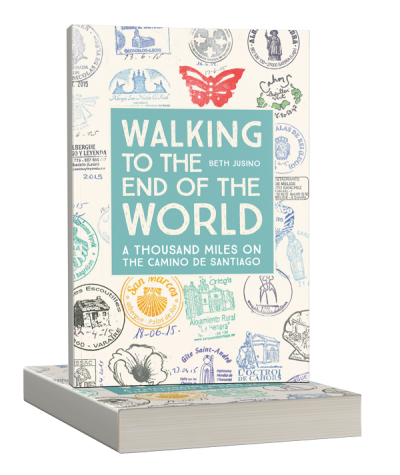Walking to the End of the World
By BETH JUSINO



What happens when two sheltered Americans take a three-month break from careers, home, and the Internet to backpack a 900-year-old trail across Europe?
Walking to the End of the World is my “travel guide masquerading as a memoir.” Here’s the longer description from the publisher, Mountaineers Books:
In her late thirties, Beth Jusino longed to escape, at least temporarily, her busy urban life. She wanted something beyond endless meetings and 24/7 screen time. Which is how she and her husband, Eric, found themselves laden with backpacks and nerves, stepping out of a historic cathedral in Le Puy, France, heading down a cobblestone street, and turning west. They were walking the Camino de Santiago, a 900-year-old pilgrimage route that winds a thousand miles across the Pyrenees and through France and Spain.
Despite months of meticulous planning, Beth discovered she was woefully unprepared once they hit the trail. Her limited French (le pomme est rouge) and the unaccountably closed shops and cafes presented early obstacles, while her perpetually problematic feet, dubbed “The Princesses,” threatened to end the adventure more than once.
But the famed Camino always provides, and in time, Beth found a way to break free from the routines and expectations of everyday life and embrace the challenges, as well as the gifts of friendship and perspective she discovered along the way.
Infused with humor and gentle irony, Walking to the End of the World is a warm-hearted and engaging story about letting go, getting outside, and living at a human pace.
You can also find out more, and follow the publishing adventure, at Camino Times Two.
Sneak Peak
As the train cleared the station, we collapsed into the last seats available, near the bathroom and facing backward. I get sick on moving vehicles, especially if I’m facing backward. But at least we were going to the right place. And after this, we’d be on foot. Surely it would be easier on foot.
Or maybe not. The pattern of those confusing ten minutes in the train station, I learned, would repeat itself over the next three months. I was sure that four years of reading every book, researching every item we carried, and soaking in the details of the Camino de Santiago, the Way of Saint James, would make me feel prepared. (I really like being prepared.)
But then, practically every day, the Camino threw me something unexpected. The train platform switch. The cow on the wrong side of the fence. The castle on the hill. The miracle sheep. The entire town that was “closed for rest.” The missing woman. The river perfect for swimming. And the people . . . the many, many people.
Somewhere I read that each person who walks the Camino de Santiago experiences it in three stages. Regardless of how far they go, what shape they’re in, or why they think they’re there, the first third of their journey will be a test of the body, the second a test of the mind, and the final third a gift to the soul.
Seventy-nine days gave us a lot of time for tests and gifts.
When we got home, people would ask, “How was your trip?” How does a person answer that? It was beautiful. Painful. Perspective changing. It taught me that there are some things I just can’t prepare myself for.
The only way to really explain it is to share it. So here we go.
GR65 leads west, toward the remains of Saint Jacques. The rivers in France, at least in that area, run south toward the Mediterranean. The result is that we constantly climbed and descended steep, rocky river valleys. Our first few kilometers were all uphill. We occasionally saw other people on the trail who passed us with happy “Bonjours” and “Bon chemins” (“Good way”).
Just past a cluster of houses guarded by well-fed French chats, the trees cleared, leaving only bright green, early spring scrub grass on a rocky outcropping. And on top of the rock, a castle. Or, at least, the ruins of a castle. A crumbling keep balanced on the crest, watching over the river valley. Below the tower stood an intact chapel, built of stone that seemed to extend directly from the hillside and crowned with a roof of seemingly haphazard tiles and a belfry with real bells. The date on the lintel read 1328.
Where I grew up, a fort three hundred years younger than this would be designated a national monument, with school tours and park rangers. Here, though, there weren’t even fences or warning signs to keep us away. Eric and I shed our packs and set out to explore. While he climbed to the keep, I ducked under the low doorway to the chapel. It was cramped and dark inside, with a few wooden benches and a rough floor, broken through in places by the granite bedrock below.
A children’s song from Sunday school played in my head: The wise man built his house upon the rock . . .
Back outside, I climbed to the keep and looked out over the valley below. I could see a train winding along the river, and in the distance I could make out Monistrol d’Allier. It seemed impossibly far away to be only our halfway point for the day, but at least it was downhill. I tried not to look at the rows of mountains behind it. Those would come later. This was now.
In the opening paragraphs of her memoir Tracks, Robyn Davidson says, “There are some moments in life that are pivots around which your existence turns—small intuitive flashes, when you know you have done something correct for a change, when you think you are on the right track . . . .[This] was one of them. It was a moment of pure, uncomplicated confidence—and lasted about ten seconds.” That was me. I was on top of a mountain, beside a French castle, on a spring morning. I was past my lists, my maps, my plans.
I was entirely present.
Hear Beth read this excerpt of her story: https://youtu.be/aon6abviLh8
Watch Beth tell her Camino story at Ignite Seattle: https://youtu.be/d1f3I-yY0D4
